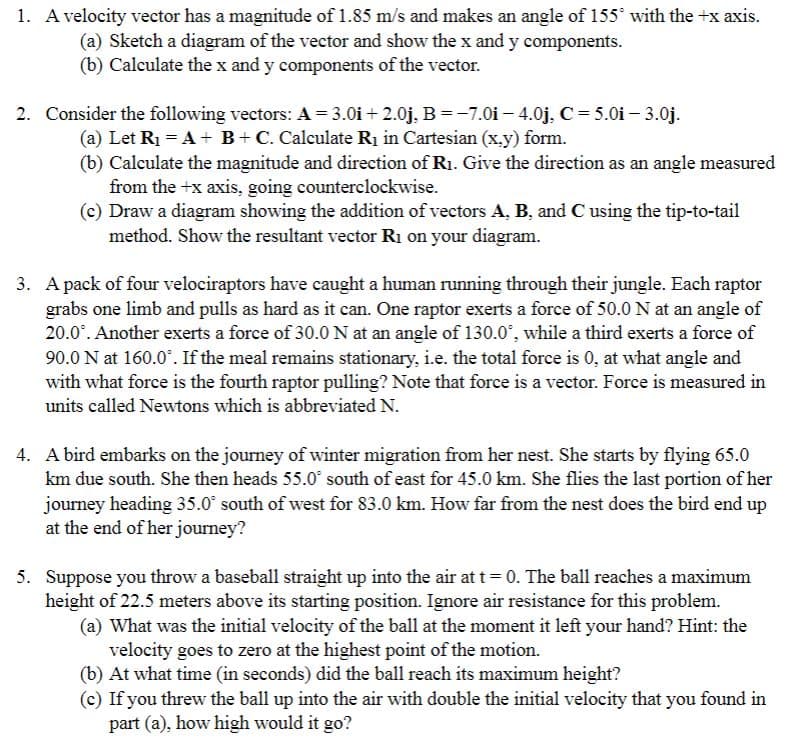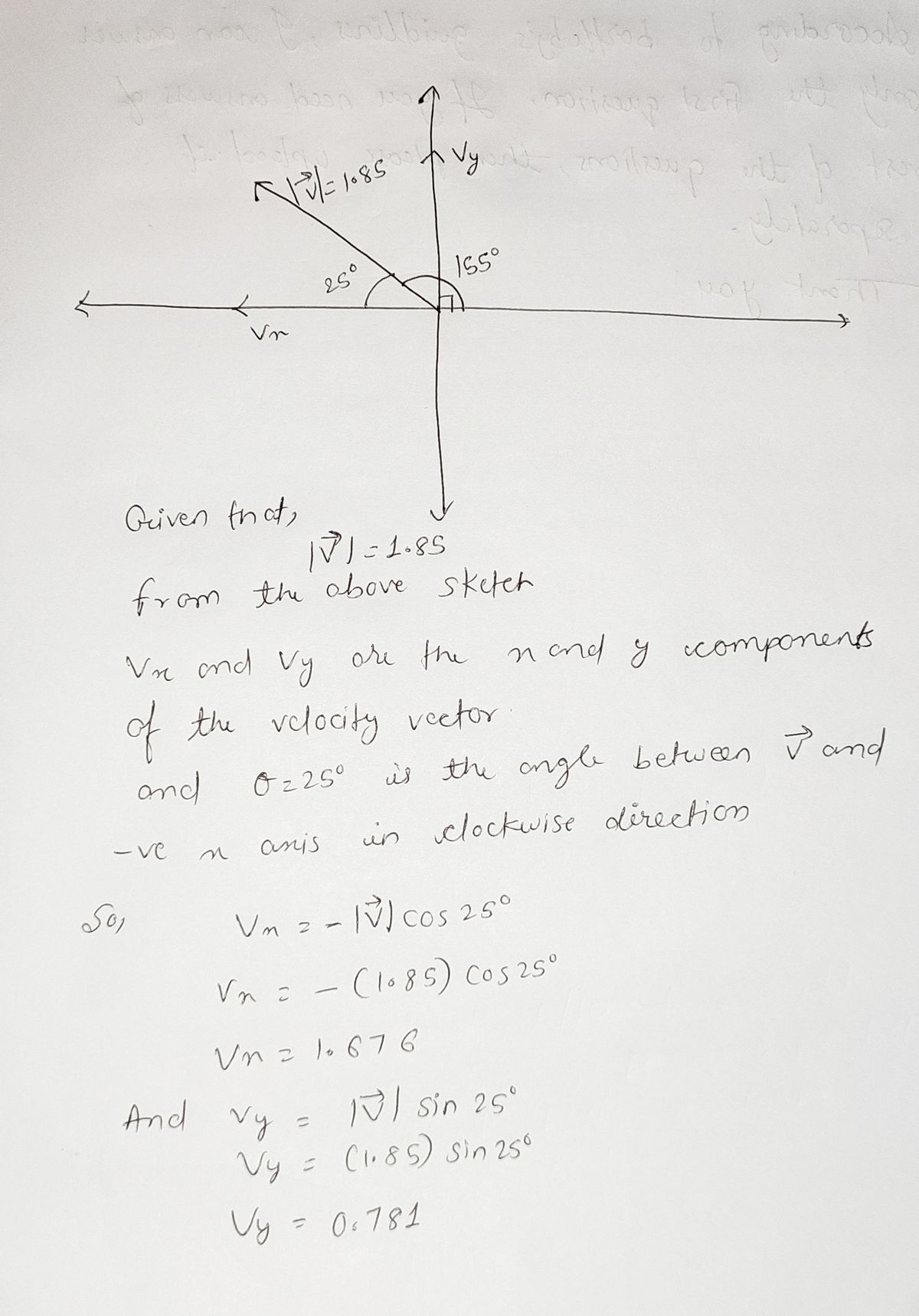1. A velocity vector has a magnitude of 1.85 m/s and makes an angle of 155° with the +x axis. (a) Sketch a diagram of the vector and show the x and y components. (b) Calculate the x and y components of the vector.
1. A velocity vector has a magnitude of 1.85 m/s and makes an angle of 155° with the +x axis. (a) Sketch a diagram of the vector and show the x and y components. (b) Calculate the x and y components of the vector.
College Physics
10th Edition
ISBN:9781285737027
Author:Raymond A. Serway, Chris Vuille
Publisher:Raymond A. Serway, Chris Vuille
Chapter3: Vectors And Two-Dimensional Motion
Section: Chapter Questions
Problem 60AP: Figure P3.60 illustrates the difference in proportions between the male (m) and female (f)...
Related questions
Question

Transcribed Image Text:1. A velocity vector has a magnitude of 1.85 m/s and makes an angle of 155° with the +x axis.
(a) Sketch a diagram of the vector and show the x and y components.
(b) Calculate the x and y components of the vector.
2. Consider the following vectors: A = 3.0i + 2.0j, B=-7.0i – 4.0j, C= 5.0i – 3.0j.
(a) Let R1 = A + B+ C. Calculate Rị in Cartesian (x.y) form.
(b) Calculate the magnitude and direction of R1. Give the direction as an angle measured
from the +x axis, going counterclockwise.
(c) Draw a diagram showing the addition of vectors A, B, and C using the tip-to-tail
method. Show the resultant vector Rı on your diagram.
3. A pack of four velociraptors have caught a human running through their jungle. Each raptor
grabs one limb and pulls as hard as it can. One raptor exerts a force of 50.0 N at an angle of
20.0°. Another exerts a force of 30.0 N at an angle of 130.0°, while a third exerts a force of
90.0 N at 160.0°. If the meal remains stationary, i.e. the total force is 0, at what angle and
with what force is the fourth raptor pulling? Note that force is a vector. Force is measured in
units called Newtons which is abbreviated N.
4. A bird embarks on the journey of winter migration from her nest. She starts by flying 65.0
km due south. She then heads 55.0° south of east for 45.0 km. She flies the last portion of her
journey heading 35.0° south of west for 83.0 km. How far from the nest does the bird end up
at the end of her journey?
5. Suppose you throw a baseball straight up into the air at t= 0. The ball reaches a maximum
height of 22.5 meters above its starting position. Ignore air resistance for this problem.
(a) What was the initial velocity of the ball at the moment it left your hand? Hint: the
velocity goes to zero at the highest point of the motion.
(b) At what time (in seconds) did the ball reach its maximum height?
(c) If you threw the ball up into the air with double the initial velocity that you found in
part (a), how high would it go?
Expert Solution
Step 1

Trending now
This is a popular solution!
Step by step
Solved in 2 steps with 2 images

Knowledge Booster
Learn more about
Need a deep-dive on the concept behind this application? Look no further. Learn more about this topic, physics and related others by exploring similar questions and additional content below.Recommended textbooks for you

College Physics
Physics
ISBN:
9781285737027
Author:
Raymond A. Serway, Chris Vuille
Publisher:
Cengage Learning

Principles of Physics: A Calculus-Based Text
Physics
ISBN:
9781133104261
Author:
Raymond A. Serway, John W. Jewett
Publisher:
Cengage Learning

Physics for Scientists and Engineers with Modern …
Physics
ISBN:
9781337553292
Author:
Raymond A. Serway, John W. Jewett
Publisher:
Cengage Learning

College Physics
Physics
ISBN:
9781285737027
Author:
Raymond A. Serway, Chris Vuille
Publisher:
Cengage Learning

Principles of Physics: A Calculus-Based Text
Physics
ISBN:
9781133104261
Author:
Raymond A. Serway, John W. Jewett
Publisher:
Cengage Learning

Physics for Scientists and Engineers with Modern …
Physics
ISBN:
9781337553292
Author:
Raymond A. Serway, John W. Jewett
Publisher:
Cengage Learning

Physics for Scientists and Engineers
Physics
ISBN:
9781337553278
Author:
Raymond A. Serway, John W. Jewett
Publisher:
Cengage Learning

Glencoe Physics: Principles and Problems, Student…
Physics
ISBN:
9780078807213
Author:
Paul W. Zitzewitz
Publisher:
Glencoe/McGraw-Hill

Physics for Scientists and Engineers: Foundations…
Physics
ISBN:
9781133939146
Author:
Katz, Debora M.
Publisher:
Cengage Learning